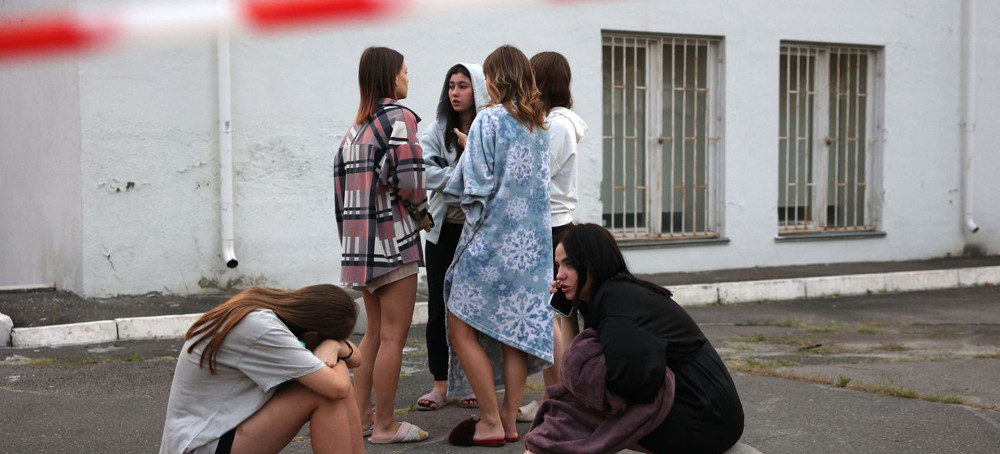As Ukrainian Children Return to School, Russia Launches Missiles at Educational Facilities
Dinara Khalilova The Kyiv Independent Students of the International Academy of Personnel Management watch emergency teams work to extinguish a fire in one building of their educational institution after a missile attack in Kyiv, Ukraine. (photo: Getty)
Students of the International Academy of Personnel Management watch emergency teams work to extinguish a fire in one building of their educational institution after a missile attack in Kyiv, Ukraine. (photo: Getty) As Ukrainian Children Return to School, Russia Launches Missiles at Educational Facilities
Dinara Khalilova The Kyiv IndependentALSO SEE: Russian Attack on Ukraine Overnight Injures 43, Kills 7, Including 2 Kids
In just three days, Russian strikes damaged at least 12 educational institutions, including a military institute, an aviation institute, a university, and schools across Ukraine, killing and injuring dozens of people.
"This is a deliberate campaign to intimidate Ukrainians,” said Roman Hryshchuk, a lawmaker and member of the education committee in the Ukrainian parliament, to the Kyiv Independent, “aiming to instill fear and hinder our ability to act rationally, which impacts both our educational process and overall quality of life."
Though attacks against educational institutions have intensified in recent days, it is not a new Russian tactic.
Since February 2022, Russia’s war has destroyed 400 and damaged over 3,500 educational facilities across Ukraine, according to the Education Ministry, and forced around 900,000 Ukrainian children to study remotely.
In addition to physical damage and ongoing threats to students’ lives, education in Ukraine is also hampered by frequent power outages caused by Russian attacks on the country’s energy grid. Regular air raid alerts force students to take shelter, disrupting their learning and sleep.
The back-to-school day on Sept. 2 was marked by a massive Russian air attack in the early morning, just hours before students were preparing to go to class. The attack targeted Kyiv, Sumy, and Kharkiv oblasts, damaging several educational facilities along with other buildings.
UNICEF Ukraine published a statement following the attack, emphasizing that it had further hindered learning for children in the country, who have already been showing signs of widespread learning loss.
“The killing and maiming of children, and attacks on schools are grave violations of children’s rights. Children’s right to education needs to be protected,” said John Marks, Deputy Representative of UNICEF in Ukraine.
“As the war continues, they need safe learning environments where they can interact and develop with their peers. Ultimately, children in Ukraine need an end to the war, so they can enjoy being children again.”
The next day, Russia targeted Poltava in central Ukraine with two ballistic missiles, striking the Military Institute of Communications and a neighboring medical facility. The attack was one of the deadliest in the ongoing war, killing 53 people and wounding nearly 300.
On the evening of Sept. 3, Russian forces used a glide bomb to strike Sumy, damaging a building of the Sumy State University. Over 12,000 students study at the university, according to its website, including Daryna Kichko.
Kichko told the Kyiv Independent that she was shocked to learn her university had been hit, even though explosions have become an almost daily occurrence in the city so close to the Russian border.
“It is very difficult to comprehend that I passed by this building literally yesterday, and now it is destroyed. This is an ordinary educational building, where, until yesterday evening, there were departments and a sports hall, in which both students and residents of the city exercised,” Kichko said.
“Everyone was very worried about the students who live nearby in the dormitory. Fortunately, there were no casualties.”
Another tragic night followed on Sept. 4, when Russian troops launched missiles and drones against Ukraine, killing seven people, including two children, and injuring over 60. Three schools in Lviv and four educational institutions in Kryvyi Rih, Dnipropetrovsk Oblast, were damaged, according to local officials.
“Only three days of studying have passed… Three schools and the Creativity Center were affected. Hundreds of windows, doors, roofs,” Andrii Zakaliuk, the head of the education department at Lviv City Council, said on Facebook following the attack.
Decisions on whether educational facilities operate in-person, virtually, or in a hybrid format are often made on an individual basis, depending on the presence of a bomb shelter in the building and the security situation in the area. According to the United Nations, last year, only one-third of Ukrainian children were able to attend school in person.
In Lviv, like in other areas of western Ukraine, most pupils study offline since this region is relatively safe due to the greater distance from the front lines and the Russian border. This access to offline learning in western Ukraine is the key reason why Iryna Polikarchuk, the mother of a five-year-old girl who left Dnipro for Khmelnytskyi, another Ukrainian city in the west, doesn’t plan to return anytime soon.
“Due to the number of alarms and the intensity of attacks, I do not think it’s possible to provide children with a high-quality educational process and the opportunity for development (in Dnipro),” said Polikarchuk.
Kichko, whose university in Sumy had been using a hybrid learning format since 2022 but switched to fully online learning after the Sept. 3 airstrike, said she doesn’t plan to transfer to a university in a safer region.
“Even in such conditions, our life continues,” Kichko said, referring to the recently intensified air attacks on Sumy. “The desire to develop our university and the city of Sumy has not disappeared; it has only become stronger.”
